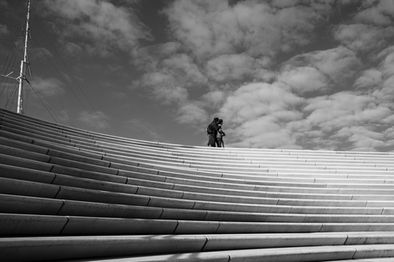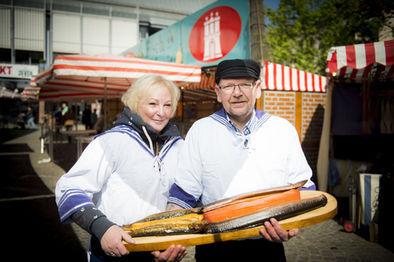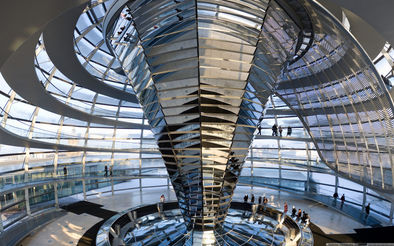
Berlin & Hamburg 2025
Nine Day Photography Workshop
We’re very excited that Berlin and Hamburg will be the destinations of our Spring, 2025 photography workshop. Over nine days and nights we'll have the opportunity to immerse ourselves in two of Germany's most dynamic cities.
In addition, we've scheduled this workshop to coincide with the European Month of Photography, a fantastic international image-based festival with exhibitions, talks and events going on throughout Berlin. This festival is a true celebration of photography and image-based media (books!).
More about EMOP is on the details page.
For inquiries, please email:
Contrasts & Confluence

Hamburg
Nearly as cool as Berlin but with a very different atmosphere, we’ll spend two days shooting on the streets of Hamburg. A beautiful port city with a thriving cultural scene, Hamburg is off the radar, a surprising gem waiting to be discovered.
The city is defined by its relationship with two bodies of water: the Elbe River and Alster lake. The promenade on the southern edge of the lake is a fantastic spot to shoot, with a stepped terrace rising from the waterfront toward a boulevard featuring elegant century-old buildings.
Hamburg has sprawling outdoor markets along the Elbe, alongside the gorgeous glass-roofed Altona Fischauktionshalle. This is where Hamburg’s night and day converge, with a mix of vendors selling everything from pike to pineapple, to all night party people leaving the clubs. This location is sure to be a photo-rich environment.
Hamburg boasts the world’s largest model railway, Miniatur Wunderland, which is epic in both scale and creativity, spread over two floors of an old warehouse in the Speicherstadt. Like Hamburg itself, Wunderland is simultaneously beautiful, impressive and lots of fun.
A two-hour high speed train will take us back to Berlin, where we’ll spend our last two days continuing to shoot, visiting exhibitions and, most importantly, presenting our work to the group. Our last evening is always reserved for final presentations and celebratory drinks and dinner.


Photography Festival
Dan and I have planned this workshop to coincide with the European Month of Photography taking place throughout Berlin, which showcases a wide range of exhibitions and events on historic and contemporary photography. We know you'll benefit from the hands-on immersive experience our workshop provides, and also from being exposed to other image-makers from around the world.
We believe that turning you on to storytellers and artists you may not be familiar with is hugely beneficial to your own practice. During our stay in Berlin we’ll attend festival exhibitions and talks which will fuel and energize your work. We’re taking you on a deep dive into the capital of freedom and culture, supported by the city-wide love of photography, while working with each of you on your own creative endeavors.


Berlin
It’s impossible not to be captivated by Berlin’s energy, vibrance and creativity. A city like no other, Berlin is a modern metropolis with a fascinating cultural landscape, with monuments to its tumultuous past everywhere. We’ve chosen this environment for its rich history and storytelling potential.
On foot and via Berlin’s incredible maze of U-Bahns, we’ll visit the city’s diverse neighborhoods, including Mitte, Kreuzberg, Charlottenburg, Neukolln and Schoenberg. We’ll check out Checkpoint Charlie, Templehofer Feld—an abandoned airport turned gigantic park—the Reichstag and the Brandenberg Gate, widely considered to be Berlin's most iconic landmark, a shining symbol of freedom and reunification after four decades of Cold War division. If time allows, we'll also make a trip to the iconic Bauhaus.
This will be a workshop filled with the rich photographic and cultural opportunities Berlin is known for, including its thriving food and drink scene.


Details & Pricing
This nine-day itinerary is crafted to offer you the most comfortable, high-end creative and cultural experience, including carefully selected hotels, inns, restaurants and transportation. The price is (nearly) all inclusive, highly personal, and led by two dedicated instructors, Elena and Dan.
Berlin & Hamberg Itinerary
What's Included:
-
Price reflects standard single accommodation in good hotels
-
All breakfasts and 6 dinners
-
Trains & metros during week
-
Guides and entrance fees
-
Pre-workshop notes and logistical assist
-
Post-workshop Zoom review (group)
-
Access to Dan & Elena (all day)
-
Partner rate furnished upon request *
What's Excluded:
-
Airfare from home country
-
Airport transfers
-
Travel and medical insurance
-
Any fees or charges that you incur as a result of you canceling this trip once you have made a reservation
-
Expenses for alternate arrival/departure
-
Alcohol other than beer or wine at dinner
*First Meet:
*Introductions & dinner, 5 PM, 1 March
*Last Meet:
Breakfast, 9 March
- Returning participants receive a 5% discount
- Those who pay in full before 1 September, 2024 receive a 5% discount
If you choose to pay with a credit card there will be a 3% processing fee
For more information, payment options and other questions, please email directly
Tirana
The capital, with a population of over half a million and growing more cosmopolitan with new restaurants, shops, and galleries joining the almost surrealist pastiche of testaments to the city’s past. Here, eras collide. We’ll visit Skanderbeg Square, recently renovated with new fountains and rosy granite paving, and home to an 18th-century mosque and minaret, a domed Albanian Orthodox church, a set of government buildings that echo the fascist architecture of Mussolini’s Italy and a Brutalist monolith that houses the National Historical Museum. We'll see the newly opened Secret Surveillance Museum and Bunk’Art, Dictator Hoxha’s five-story underground nuclear bunker.
We’ll spend the first two nights at the centrally located Rogner, an extremely comfortable hotel with a pool and spa.


Korce
Known as the Paris of Albania, Korce is a beloved city of cobblestone streets, high hills, historic spice and food bazaars, and plenty of busy bars and cafes. Renowned for its exceptional cuisine, like lakror--spinach and cheese pie whose recipe has been passed down through generations. Korce has a laid-back atmosphere with culturally significant architecture and museums.
We'll explore Korce's French-style villas, iconic cobblestone boulevards, medieval art and photography collection and, of course, sample the famous beer of Korce.


Shkoder
This beautiful and historic city is situated between Lake Shkoder and the foothills of the Albanian Alps. It is one of the oldest and continuously inhabited cities in the Balkans. Shkoder is regarded as the traditional capital of Northern Albania and is renown for its arts, culture and religious diversity.
We’ll have a curator-led walk through of the Marubi National Museum of Photography, a gorgeous, modern archive showcasing the history of photography in the city of Shkoder. We’ll visit renown churches and mosques as well as the Venice Art Mask Factory where "30,000 masks per year are made using the labour-intensive cartapesta technique”. For those who wish to bike, we’ll pedal around Lake Shkoder and visit a small atilier of traditional women weavers.
Two nights will be spent at Hotel Tradita, a boutique inn with incredible charm, delicious food and homemade liqueur.


Voskopoje
While based in Korce we'll visit the beautiful, high mountain village of Voskopoja, known for its spectacular post-Byzantine-style churches with floor-to-ceiling icon paintings. We’ll dine at a mountain restaurant with some of the best traditional food in the country.


Berat
Berat is a charming and beloved city as well as a UNESCO World Heritage site. A striking feature is the collection of white Ottoman houses that dot the hills to the castle. Berat is surrounded by mountains, and locals flock to the outdoor cafes lining the Osum river that runs through the city. We'll be guided through the city by a native Berati.
Lodging for one night in a centrally located hotel.


Shkoder
This beautiful and historic city is situated between Lake Shkoder and the foothills of the Albanian Alps. It is one of the oldest and continuously inhabited cities in the Balkans. Shkoder is regarded as the traditional capital of Northern Albania and is renown for its arts, culture and religious diversity.
We’ll have a curator-led walk through of the Marubi National Museum of Photography, a gorgeous, modern archive showcasing the history of photography in the city of Shkoder. We’ll visit renown churches and mosques as well as the Venice Art Mask Factory where "30,000 masks per year are made using the labour-intensive cartapesta technique”. For those who wish to bike, we’ll pedal around Lake Shkoder and visit a small atilier of traditional women weavers.
Two nights will be spent at Hotel Tradita, a boutique inn with incredible charm, delicious food and homemade liqueur.


Beirut
Beirut embodies the beauty and spirit of Lebanon. With its liberal (hedonistic?) leanings it is one of the great capitals of the Middle East. Inhabited by about two million people, it is a city full of history, emotions and division. Although the scars of the past are visible on the surfaces of the buildings, Beirut is a safe, vibrant and exciting city.
Beirut’s history started about 5,000 years ago. At one point it was completely destroyed by an earthquake and tidal wave. After World War I most of its ancient quarters were demolished and replaced by Oriental style buildings. At the beginning of the French mandate in 1920, Beirut established itself as the 'Paris of the Middle East,’ and became the capital of Greater Lebanon. It is in this fabled city where we’ll begin our photography workshop.
We’ll spend three days photographing throughout the distinctive neighborhoods of Mar Michael, Hamra, Aschrafieh, Gemmaze, Sursock and the Corniche--the iconic promenade which pulses with activity. Of course, we’ll eat (and drink) and partake in a bit of the city’s famed nightlife.


Byblos & Tripoli
Leaving Beirut we'll head north up the coast to the archeological site of Byblos, and the ancient city of Tripoli, offering two very distinct shooting and cultural experiences.
Byblos, a UNESCO world heritage city, has been continuously inhabited for centuries. It was here that the Phoenician alphabet was developed. Tripoli is the country’s second largest city, and one of the most traditional places in Lebanon. Predominantly Sunni, Tripoli is a friendly and lively city with beautiful architecture, traditional souks full of artisans, and the World's Fairgrounds--Oskar Neirmeyer's unfinished architectural wonder. In between these two cities we’ll stop for lunch in the surf town of Batroun.
We’ll spend one night in a mountain hotel in Ehden


The Cedars
The bread basket of Lebanon, the Bekka Valley, is reknown for its beautiful andscapes and emphasis on food and all things local. Here, we’ll spend time photographing and hiking in small villages and experience the famous Shouf Biosphere and Cedar Forest, the same trees cited in the Bible. The Shouf is one of the oldest documented forests in history, estimated to be 2,000 years old. The reserve incorporates the Ammiq Wetland, a remnant of the extensive marshes and lakes that once covered parts of the beloved Bekaa Valley. This is one of our favorite places in Lebanon.
We'll end our day at Tawlet Ammiq, one of the most beloved eco- restaurants featuring local and sustainable home-grown food and wine--and a fantastic atmosphere.


Qadisha Valley
The Qadisha Valley is one of the most important early Christian monastic settlements in the world, and a UNESCO world heritage site. Here, there are several incredible monasteries, some carved directly into the mountains. After exploring the ancient sites we'll hike among the wildflowers in the valley below, with a view of Lebanon’s highest peak (Qornet As Sawda) soaring above. This is truly a peaceful and beautiful part of the country. Nearby, we’ll also visit the Kahlil Gibran museum, Lebanon’s most beloved poet.


Baalbek & Bekka Valley
From the Qadisha Valley we’ll make our way east to the ancient town of Baalbek, inhabited as early as 9000 BCE, and an important pilgrimage site in the ancient world for the worship of the sky-god Baal.We’ll spend the afternoon wandering through the magnificently preserved Temple of Bacchus and the vast adjacent Temple of Jupiter.
Two nights will be spent at a hotel in the gorgeous Bekka Valley.


Tyre
We’ll continue south to Tyre, an ancient port on the edge of the Mediterranean and, at 4,000 years, one of the oldest cities in the world. The historic souks and Ottoman-style architecture offer a full-sensory experience. We’ll explore a tangle of busy, winding streets, historical markets, and seaside life. Tyre’s religious divide is microcosmic of Lebanon’s larger struggles, where historically constructed sectarian differences resulted in territorial demarcations. Despite past conflicts, the heart of Tyre remains warm and hospitable.
We'll spend one night in a centrally located Hotel.
Making our way back to Beirut we’ll stop in Saidon to sample their famous sweets and pastries and, if time allows, photograph inside a traditional soap factory.


Beirut
Beirut embodies the beauty and spirit of Lebanon. With its liberal (hedonistic?) leanings it is one of the great capitals of the Middle East. Inhabited by about two million people, it is a city full of history, emotions and division. Although the scars of the past are visible on the surfaces of the buildings, Beirut is a safe, vibrant and exciting city.
Beirut’s history started about 5,000 years ago. At one point it was completely destroyed by an earthquake and tidal wave. After World War I most of its ancient quarters were demolished and replaced by Oriental style buildings. At the beginning of the French mandate in 1920, Beirut established itself as the 'Paris of the Middle East,’ and became the capital of Greater Lebanon. It is in this fabled city where we’ll begin our photography workshop.
We’ll spend three days photographing throughout the distinctive neighborhoods of Mar Michael, Hamra, Aschrafieh, Gemmaze, Sursock and the Corniche--the iconic promenade which pulses with activity. Of course, we’ll eat (and drink) and partake in a bit of the city’s famed nightlife.


Byblos & Tripoli
Leaving Beirut we'll head north up the coast to the archeological site of Byblos, and the ancient city of Tripoli, offering two very distinct shooting and cultural experiences.
Byblos, a UNESCO world heritage city, has been continuously inhabited for centuries. It was here that the Phoenician alphabet was developed. Tripoli is the country’s second largest city, and one of the most traditional places in Lebanon. Predominantly Sunni, Tripoli is a friendly and lively city with beautiful architecture, traditional souks full of artisans, and the World's Fairgrounds--Oskar Neirmeyer's unfinished architectural wonder. In between these two cities we’ll stop for lunch in the surf town of Batroun.
We’ll spend one night in a mountain hotel in Ehden


The Cedars
The bread basket of Lebanon, the Bekka Valley, is reknown for its beautiful andscapes and emphasis on food and all things local. Here, we’ll spend time photographing and hiking in small villages and experience the famous Shouf Biosphere and Cedar Forest, the same trees cited in the Bible. The Shouf is one of the oldest documented forests in history, estimated to be 2,000 years old. The reserve incorporates the Ammiq Wetland, a remnant of the extensive marshes and lakes that once covered parts of the beloved Bekaa Valley. This is one of our favorite places in Lebanon.
We'll end our day at Tawlet Ammiq, one of the most beloved eco- restaurants featuring local and sustainable home-grown food and wine--and a fantastic atmosphere.


Qadisha Valley
The Qadisha Valley is one of the most important early Christian monastic settlements in the world, and a UNESCO world heritage site. Here, there are several incredible monasteries, some carved directly into the mountains. After exploring the ancient sites we'll hike among the wildflowers in the valley below, with a view of Lebanon’s highest peak (Qornet As Sawda) soaring above. This is truly a peaceful and beautiful part of the country. Nearby, we’ll also visit the Kahlil Gibran museum, Lebanon’s most beloved poet.


Baalbek & Bekka Valley
From the Qadisha Valley we’ll make our way east to the ancient town of Baalbek, inhabited as early as 9000 BCE, and an important pilgrimage site in the ancient world for the worship of the sky-god Baal.We’ll spend the afternoon wandering through the magnificently preserved Temple of Bacchus and the vast adjacent Temple of Jupiter.
Two nights will be spent at a hotel in the gorgeous Bekka Valley.


Tyre
We’ll continue south to Tyre, an ancient port on the edge of the Mediterranean and, at 4,000 years, one of the oldest cities in the world. The historic souks and Ottoman-style architecture offer a full-sensory experience. We’ll explore a tangle of busy, winding streets, historical markets, and seaside life. Tyre’s religious divide is microcosmic of Lebanon’s larger struggles, where historically constructed sectarian differences resulted in territorial demarcations. Despite past conflicts, the heart of Tyre remains warm and hospitable.
We'll spend one night in a centrally located Hotel.
Making our way back to Beirut we’ll stop in Saidon to sample their famous sweets and pastries and, if time allows, photograph inside a traditional soap factory.

